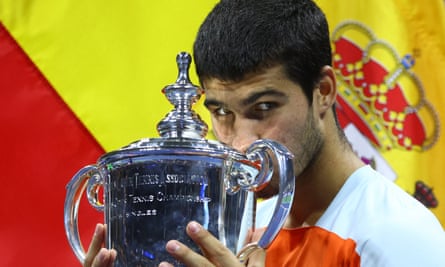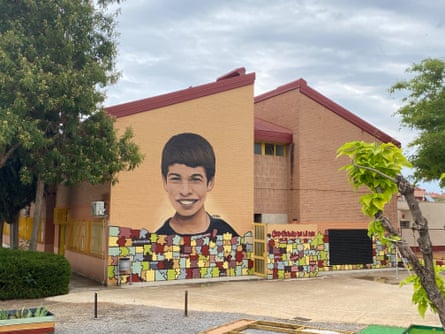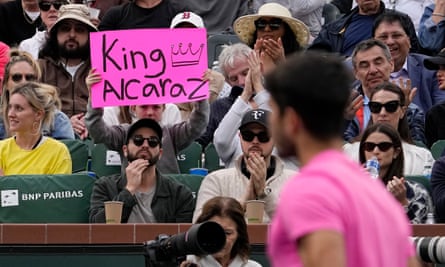In the south-eastern corner of El Palmar, a village in south-eastern Spain, the Real Sociedad Club de Campo sits in the mountains overlooking the Murcia region’s eponymous capital city. Exactly 100 years ago, the club was founded solely as a hunters’ society, where those of privileged backgrounds would convene to shoot pigeons out of the sky. Its evolution into a handsome private tennis club has unexpectedly positioned it as the place where many people first glimpsed the player who could be the future of the men’s game.
It was on the grounds of Tiro de Pichón (Pigeon Strike), as the club is still colloquially known as today, where many people saw Carlos Alcaraz and left with the belief that they had seen something special.
“He began to play with his dad, and one day [his father] asked me to watch him. This kid, at four, five years old, was spectacular,” says Kiko Navarro, who was coached there by Alcaraz’s father, Carlos Sr, in his youth before eventually becoming one of Alcaraz Jr’s early coaches.
“I knew from very young that he was incredible,” Navarro says. “I’m not going to say that I was thinking he was going to be world No 1 but I knew that I had a really good and different player on my hands.”
Alfredo Sarria is a close friend and longtime business partner of Carlos Sr, whom he likens to a brother, and the pair run the Carlos Alcaraz Academy together at Tiro de Pichón. After first seeing a four-year-old Alcaraz in action while playing padel with his brother, Álvaro, Sarria was also enthused by his potential.
“When he was young you saw that he was very good, that he was going to be a champion,” Sarria says. “But hey, you say it with a ‘small mouth’ – you say it without completely believing everything you say.”
Alcaraz’s roots are entrenched in the club, which has 13 tennis courts and four padel courts as well as a swimming pool, a gym, a basketball court and a football pitch. His grandfather, also Carlos, learned how to play tennis there and he eventually became a prominent member, helping to mould it into the modern sporting club it is today.

His passion for tennis was passed down to Alcaraz’s father, who took the dream forward by competing at a high level within Spain. Still, he did not have the funds to pursue a serious professional career. He eventually became a tennis coach and administrator in tennis and padel.
It took three generations in the Alcaraz lineage for a true breakthrough but the wait has been worthwhile. Alcaraz has arrived at the French Open, which starts on Sunday, as the world No 1 and one of the tournament favourites after a historic 2022 that included him becoming a grand slam champion at the US Open and the ATP’s first ever teenage No 1 at 19.
Around the club, various members have vivid memories of witnessing a passionate young Carlitos (“Little Carlo”), as he is widely known, in his earliest days. Sarria recalls a time when he arrived at the club for a meeting with Alcaraz’s father: “I went to look for Carlos Sr and there I find Carlitos watching a game between grandparents by the fence on court three,” he says, laughing. “He knew how they were faring, he told them the mistakes they were making: ‘You have to serve here.’ He has a passion for tennis.”
At a time when modern tennis has become dominated by attritional rallies from the baseline, one of the defining aspects of Alcaraz’s success is the way he has achieved it. He burst into the sport playing dynamic, creative all-court tennis, demolishing forehands, smothering opponents with an unending stream of drop shots and constantly looking to flit forward to the net.
“Just as you see him hit 20 drop shots per match today, he hit them at 13 years old,” says David Ayuela, who captained the Spanish Junior Davis Cup team during Alcaraz’s time in it. “What’s more, when he was 13, I remember that there were people who said: ‘Oof, this boy, a lot of drop shots. So many drop shots. We’ll see when he grows up and becomes a professional.’ This is exactly the same game [he plays now].”
The variety in Alcaraz’s game is courtesy of his very first coach, his father, who taught him sound technique on each shot. But Sarria notes that all players at the academy are taught in the same way. The difference between Alcaraz and many of his peers was his willingness to implement them in matches, which allowed him to quickly become comfortable with his arsenal of shots.
“Carlos has always had the virtue from the beginning that all that he trained, he also did it in matches,” says Sarria. “So for him it was natural, even at eight years old, to spend half a match at the net. No eight-year-old spends half a match approaching the net because they know they’re going to get lobbed and passed.”
His mastery of variety and touch is also directly related to his precocity. Alcaraz’s uncle, Tomás, often tells the story of when he took him to his first tournament at five years old. Alcaraz competed against an opponent two to three years his elder, and much taller. They played with adult balls rather than the depressurised balls normally reserved for players his age.
Each time the ball bounced, it would fly over Alcaraz’s head. After losing the first set easily, at five he still had the wherewithal to adapt: “Instead of letting it bounce, he moved into the forecourt and volleyed every shot, hitting the ball without letting it bounce,” says Sarria. “And he almost won the match because he had the skill [and] he had the resources to say: ‘Well, I can’t win like this, I’m going to win this other way.’”

Since he emerged on the ATP Tour, Alcaraz has constantly stressed the necessity of competing with a smile on his face. When a smile does not easily come to him in the heat of battle, even when he is losing, it is an indication of overwhelming nerves. His on-court demeanour is unusual for a player who competes so fiercely.
This was not always the case. As a child, Alcaraz’s temper was infamous. He threw rackets in anger, he burst into tears and refused to leave the court after losses. “The truth is that Carlos had a strong personality, a big temper,” says Navarro. “He did not like to lose at all. When we were travelling around the world and he lost a match, you had to leave him for a while as he would cry. He was a bad loser.”
In Rome earlier this month, Alcaraz reminisced on his old ways with a smile: “When I was younger, I was a totally different person,” he said, laughing. “Probably I didn’t enjoy it as I’m enjoying right now. I was always mad, throwing the racket, complaining a lot. It was different. I started to calm myself, control my emotions. I started to enjoy playing tennis, enjoy a lot on the court.”
A few days into his campaign in Rome, Alcaraz suffered one of his worst ever losses, losing to the world No 135, Fabian Marozsan. It was almost as striking to see him eagerly answering questions in his press conference with a smile on his face and heaping praise on his Hungarian opponent. Even when he would rage after defeats as a child, he did not allow his frustration to linger for too long.
“There have been times when he stayed on the court and he didn’t want to get off because he didn’t want to lose,” says Sarria. “But it is also true that after 10 minutes, he had forgotten. Always. He was very pissed off, he put on a show, but after 10 minutes he had a smile on his face and had forgotten about the game.”
While many aspects of the 20-year-old’s game remain technically identical to when he was younger, there have been notable changes, including his serve and backhand. There was enough concern about the progress of Alcaraz’s backhand that there were even discussions within his camp about switching to a single-handed backhand.
Despite Alcaraz striking the single-hander well, Navarro and the rest of his team were ultimately against the change. Such episodes were reflective of his adaptability and the ease with which he learned new skills.
after newsletter promotion
“There was an issue with the serve; if you look at old video, he used to serve with his feet apart. It was very easy to change it. If you say: ‘Carlitos, hit with one hand,’ he will hit with one hand. This boy was born to be a tennis player, to be No 1,” says Navarro.
The Junior Davis Cup brings together the best players aged 16 and under in the international team competition. In 2018, the tournament was held in Budapest, with Spain and France meeting in the final.
After France took the first singles rubber, Alcaraz, a year younger than his competition, stepped up against Harold Mayot, a future junior No 1, requiring a win to keep their chances alive. Instead, he was overcome by nerves and he could not play freely. Alcaraz trailed 6-3, 5-3 and 30-40 as the match appeared to be slipping away.
“It was match point and gold medal point for France,” says Ayuela. “But Carlos Alcaraz saved it, and incredibly, he won the match.”
He returned shortly afterwards to win the decisive doubles rubber alongside his good friend Pablo Llamas. For those present, it was another of those striking indicators of his enormous potential.
After the early days of building his game and committing to the prospect of achieving something in the sport, one of the decisive moments of Alcaraz’s career occurred as his family tried to plan his first trip abroad for a world championship under-10s competition in Pula, Croatia.
The family, which includes his mother, Virginia, and three brothers, Álvaro, Jaime and Sergio, did not have the financial resources to fund an expensive tennis career. As they tried to seek out sponsors, Navarro decided to ask for financial help from a good friend who worked at Postres Reina, a local confectionery company in Murcia. He agreed to fund the trip.

“It ended up being expensive because we were four people – Carlitos’s uncle, the son of the sponsor, Carlitos and I,” says Navarro, laughing. “In the end, he reached the final against another Spaniard, Daniel Rincón. It was a really nice foundation, Carlos remembers it well. It was a really nice trip in Croatia.”
After the first successful trip, Postres Reina agreed to fund his subsequent trips as he began to travel around Spain and Europe for competitions. The company played an essential role in Alcaraz’s career and remains his sponsor today.
“When you have a large family or you have four children, you don’t want anyone to lack,” says Sarria. “You can’t invest everything in one and not the others. So Reina helped a lot and that without a doubt is one of the legs of the table for Carlos to get to where he is.”
As a person who cherishes closeness with his friends and family, even his success and progress were not always easy to swallow. Eventually, Alcaraz became too good for the players he had grown up playing with. A particularly difficult period came when he had to stop playing with his friend and lifelong training partner, Pedro Cobacho.
Sarria says: “There have been moments in which Carlos said: ‘Why isn’t this kid going to train with me any more?’ Well, he doesn’t have your level. ‘But he’s my friend. Why? No training if I am training without my friend.’ But he can’t track down your shots.”
The Alcaraz family receives a lot of credit from their community for their role in nurturing the player and ensuring that he always felt the love and affection around him. “Tennis is an individual sport, no?” says Sarria. “But Carlos Sr has always tried to make it look more like a team sport, in the sense of that support. In the end, the sorrows are less sorrowful and the joys are shared.”
That feeling of community was particularly tested when Alcaraz made another important decision as he moved to Villena, just over an hour away by car, to train at Juan Carlos Ferrero’s Equelite Sport Academy. In time Ferrero, a former world No 1 and the 2003 French Open champion, took over as his coach, using his knowledge of the professional game to help guide Alcaraz to the top.
Alcaraz initially moved to Villena with Navarro and they spent two years living together until their coaching partnership came to an end. Even though he returned home on the weekends, it wasn’t an easy adjustment for Alcaraz, who missed his friends and family. “It’s difficult to take Carlitos out of Murcia,” Navarro says.

Even now, Alcaraz returns home often. Just before he sat down to talk, Sarria received a message from Alcaraz’s team asking him to book a court for the world No 1 at the club as he returned for a couple of days before heading to Roland Garros.
The club and academy are booming, partly due to the global growth in tennis participation since the early days of the pandemic, the sleek facilities and the crisp mountain air, but also because new members of the academy have been attracted by the hope of replicating Alcaraz’s success. In the clubhouse, as his kids played on the football pitch outside, a German father of tennis-playing children keenly explained that he was in the process of permanently relocating his family from the Rafa Nadal Academy in Mallorca to El Palmar.
The town has also seen some visual changes. As you enter the village from the motorway that connects it with the city of Murcia, the very first image upon entering El Palmar is an enormous mural of Alcaraz striking a backhand. It is a permanent reminder of the talented, hard-working village kid who has not forgotten the warm, tight-knit community that shaped him.




